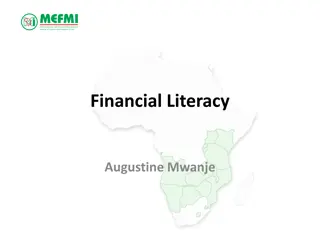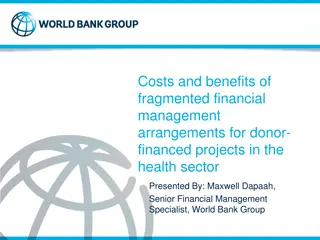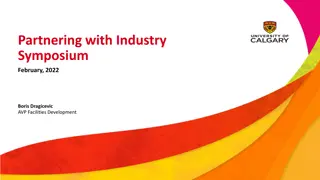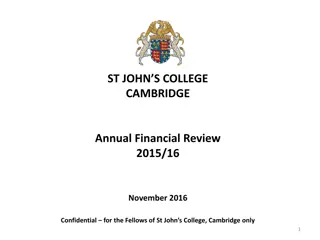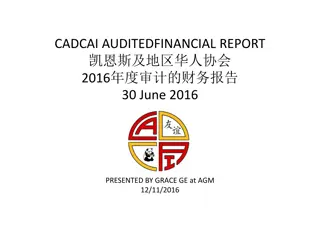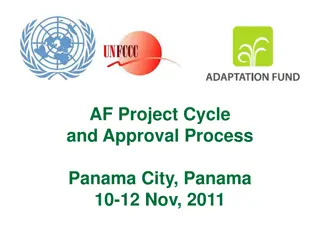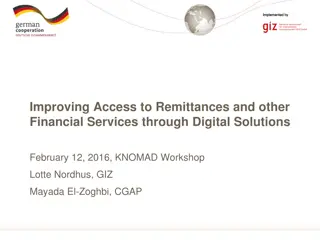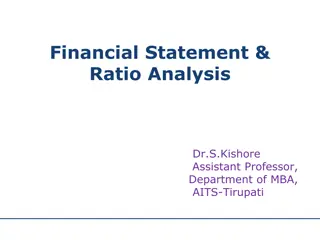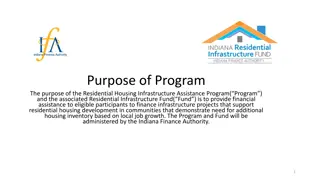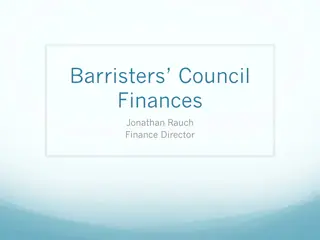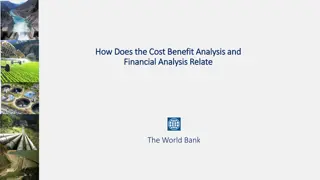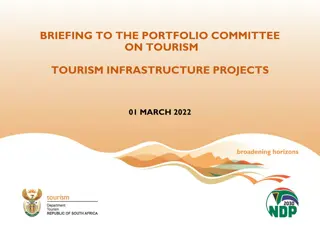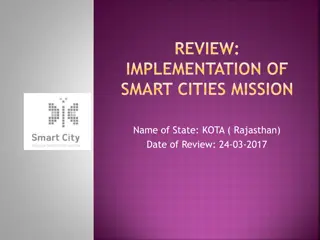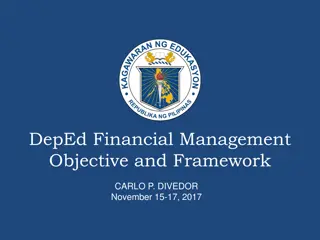Financial Guidelines Overview for Collaborative Projects
Introduction to the financial framework for collaborative projects, including budget formats, budget lines, and principles of alignment in accordance with partner universities. Details on budget limits, implementation periods, activity year breakdown, and justification requirements are provided. Key areas covered include investment costs, operational costs, personnel costs, scholarship costs, and coordination costs.
- Financial guidelines
- Collaborative projects
- Budget framework
- Partner universities
- Investment management
Uploaded on Oct 04, 2024 | 0 Views
Download Presentation

Please find below an Image/Link to download the presentation.
The content on the website is provided AS IS for your information and personal use only. It may not be sold, licensed, or shared on other websites without obtaining consent from the author. Download presentation by click this link. If you encounter any issues during the download, it is possible that the publisher has removed the file from their server.
E N D
Presentation Transcript
ITP financial guidelines - General intro
1. Introduction 2. Financial framework 3. Budget format 4. Budget lines
INTRODUCTION New proposals to reform the rules regarding budget flexibility (budget changes, reporting, ea. are currently part of an ongoing change process. As a consequence, we are not able to communicate yet on these topics. The proposals will be validated by the bodies involved such as ICON FIN WG and communicated once they are approved. spending rates, ), 4
INTRODUCTION Principles of alignment with financial guidelines of the partner universities through negotiation (in particular in the context of local guidelines for travel, mileage, scholarships, etc.) We fund cooperation The share of investment costs in the overall budget is to be kept as limited as possible, taking into account the project objectives Key aim is to improve the basic conditions in which academics have to do their job Academic personnel is to be provided by either the partner university or the Flemish universities Selected input or in-kind co-funding is assumed by the local universities (office space, waivering of tuition fees, staff support, renovation of buildings, etc) General principles: The funds are used in accordance with the principle of good financial management, meaning in accordance with the principles of (1) thrift:, (2) efficiency and (3) effectiveness (art. 33 of Royal Decree). 5
Financial framework Budget: max. budget is 150.000 EUR Implementation period: max. implementation period is 3 years. Project budget divided in budgets per activity year Activity year: 12-month period (1 Sept year X to 31 August year x+1 ) Date related expenses (e.g. mission related expenses, subscription costs, scholarship costs, etc.) need to be accounted for in the respective activity year Justification needed: these expenses must be accounted for individually with receipts, invoices, bank transactions and / or other supporting documents 7
Financial framework Overall project budget and detailed budget per activity year. Rules in terms of roll-over of budget between activity years are to be defined flexibility Budget lines: A. Investment costs B. Operational costs C. Personnel costs D. Scholarship costs E 1. Coordination costs Flemish HEI 8
Budget Format Budget lines A. Investment costs A.1. General: investment costs A.2. Vehicles A.3. ICT B. Operational costs B.1. General: goods & services B.2. Dissemination & uptake (events) B.3. ICT (operations and services) B.4. International mobility & subsistence B.5. Local mobility & subsistence C. Personnel costs ( indic. max. of XX%) C.1. Employment contracts C.2. Topping-up D. Scholarship costs D.1. Short term scholarship allowances in Belgium D.2. Study scholarship allowances in Belgium D.3. Research scholarship allowances in Belgium D.4. Short term scholarship allowances in partner country D.5. Study scholarship allowances in partner country D.6. Research scholarship allowances in partner country Total A-D E. Coordination Costs E.1. In Belgium (lump sum 10% of the A-D total) E.2. Local coordination costs (lump sum 5% of the A-D total) 10
A - INVESTMENT COSTS Investment costs: Investment costs are defined as costs incurred to acquire durable goods with a long life that can be depreciated in the accounts over several years. Budget Category A.2. Vehicles is not available. Purchases in Belgium: law of public expenditure is to be followed and in view of export VAT exemption is to be obtained in Belgium and locally no import taxes are paid (negotiate with national government in view to obtain tax exemption) 12
Investment Costs Budget Categories A.1. General Definition General investment costs, except for A2 Vehicles and A3 ICT related investment costs Examples Examples are minor infrastructure works, equipment, furniture, lab infrastructure, (non-exhaustive list) A.3. ICT Definition ICT refers to all Information and Communication Technologies. This covers equipment, software and services. Includes also all costs related to the purchase, shipment, installation and commissioning of ICT equipment, software and services. Examples are servers, LAN networks, laptops, cell phones, software, video conferencing hardware, applications, (non-exhaustive list) Examples 13
B - OPERATIONAL COSTS Operational costs: Operational costs are defined as costs incurred for the purchase and/or operational use of goods or services that are directly related to a specific project activity. Expenses in partner countries are possible under operational costs (workshops, conferences, ) NEW: All services are to be budgeted and reported under B. Operational Costs . In the case of personnel related service contracts, these are with third parties, external to the HEI.
B. Operational Costs Budget Categories B.1. General : Goods & Services Definition All operational costs, goods or services, with the exception of those costs under the specific categories B.2. Dissemination & Uptake , B.3. ICT , B.4. International mobility & subsistence & B.5. Local mobility & subsistence . Examples Examples are shipping costs, consumer goods (non-durable laboratory equipment, chemicals, documentation, books, minor materials, spare parts, project related office supplies, fuel, copies, ), representation costs, subscription costs, services rendered by third parties, (non-exhaustive list) B.2. Dissemination & Uptake Definition All costs related to the distribution of information and materials, produced by the project, to both the general public or specific targeted audiences. The focus is exclusively on the costs of the distribution of content/information/messages and not on the creation. We interpret distribution in the broadest sense of the definition (publications, events, media, ). We define dissemination & uptake as interactions with the general public or specific targeted audiences to disseminate information or materials produced by the project. This involves communicating knowledge effectively and synthesizing and repackaging project results for (non-) expert audiences and stakeholders. Examples Examples are dissemination and stakeholder events, publications for the general public/ targeted audiences, (non-exhaustive list) 15
B. Operational Costs Budget Categories B.3. ICT (operations & services) Definition ICT refers to all Information and Communication Technologies. This covers operational goods, software and small equipment that does not fall under A.3. Examples Examples are maintenance of ICT equipment and software, optimalization of software, systems and equipment, (recurring) license fees, (non- exhaustive list) B.4. International Mobility & Subsistence Definition International travel costs comprise all costs incurred for door-to-door journeys in the context of a VLIR-UOS project by project members From Flemish and partner HEI s) or external experts involved in a project activity. Examples Includes following cost categories: transportation, overnight expenses, visa costs, per diem/allowance/subsistence, insurance, healthcare related costs (COVID-19) & CO2-compensation. B.5. Local Mobility & Subsistence Definition All costs incurred for journeys within Belgium or within the partner country by project members From Flemish and partner HEI s) or external experts involved in a project activity. Local per diem max. 25 EUR/per day. (Hotel and transportation invoices to be booked separately). Examples Includes transportation, overnight expenses & per diems/allowances/subsistence. 16
Operational costs Service contracts Service contracts should be linked to project activities and support operational activities. A budget B consisting mainly of service contracts would be very questionable. Type of service contracts: Technical or non-technical ad-hoc support services (lab work, data collection and basic analysis) Consultants only selectively if no institutional experts nor Flemish expertise is available or too costly (travel) 17
Operational Costs - Guidelines International travel costs are the costs linked to the travel (door to door) by Belgian and local personnel Types of expenses Plane ticket, including airport tax Service fee of the travel agent or airline company Indirect travel costs : Visa International passport Costs arising from obtaining the necessary certificates Healthcare related costs: obligatory vaccinations; COVID 19 testing (see website VLIR-UOS) Travel insurance Residential costs are costs linked to the stay abroad of Belgians or local personnel. Hotel accommodation costs in the partner country (indicative max. per country) Hotel accommodation in Belgium : indicative max. 100 / night Per diem Mission : max. three weeks! (if training involved then see also short term scholar )
C - PERSONNEL COSTS Personnel Costs: All costs connected to the employment or subsidizing of (temporary) employees through an employment contract with the institution, within the project duration. This includes also topping-up. All personnel costs outside of an employment contract (service contracts, ) are part of budget category B. Operational Costs . 19
Personnel costs Budget Categories C.1. Employment Contracts Definition All costs connected to the employment or subsidizing of (temporary) employees through an employment contract with the institution, within the project duration. C.2. Topping-up Definition and general principles Supplement to the salary of university staff involved in the project Indicative max. 40% of gross salary Justification: salary slip To be kept to a minimum standard academic responsibilities 20
D - SCHOLARSHIP COSTS The general principle for a project/embedded scholarship is that it contributes to capacity building at level of the involved department of the partner institution. Scholarship costs are costs linked to having scholars study / conduct research either in Belgium or in the country/region of origin A new scholarship system is being developed An intake of minimum 8 scholarships per edition/training within the ITP. Types of allowance Short term: Education, training or research stays up until 6 months for which no degree is awarded and that last between: Duration: between 7 days and 6 months. 7 days and 14 days: based on a daily allowance 15 days 31 days: based on a standard monthly allowance > 1 month - 6 months: based on a standard monthly allowance (pro rata) 21
D Scholarship costs Budget categories D.1. Short term scholarship allowances in Belgium Definition Short term scholarship allowances in Flanders awarded for academic education, training or research stays lasting minimally 7 days and up to 6 months. D.4. Short term scholarship allowances in partner country Definition Short term scholarship allowances in a Partner country awarded for academic education, training or research stays lasting minimally 7 days and up to 6 months. 22
D - SCHOLARSHIP COSTS- Guidelines Short term scholarship (allowance) - Indirect travel costs : 200 EUR (lump sum) - Airline ticket - Insurance : 1.400 EUR (upon justification) : 2 EUR / day (upon justification) The allowance is differentiated on the basis of the duration of the programme and stay with a maximum of 1500 EUR for 31 days/one month: - 7 days-14 days: daily allowance of 100 EUR - 15 days - 31 days: standard allowance of 1500 EUR (not pro rata!) - >31days 6 months: allowance based on monthly fee of 1500 EUR (pro rata) Stays longer than one month the allowance is calculated pro rata, by multiplying the total number of days by the allowance of 1500 EUR, and dividing this amount by 31 Extra costs possible (esp. for accommodation, indirect travel costs)
D - SCHOLARSHIP COSTS local Local Scholarships As a general principle local scholarships may be funded from the project budget but the amounts are to be in line with university and national guidelines Types of scholarships that can be identified: Short-term scholarships in the region 24
D - SCHOLARSHIP COSTS Payments to the Flemish host unit or institution bench fee Bench fee: The bench fee is a payment to the host unit and is a contribution to the costs incurred in the provision of workspaces and laboratories, the use of study material, research equipment and computing hard-ware and software, supervision of scholars, etc. The bench fee is calculated by multiplying the bench fee amount (16 EUR) by the actual number of days the scholar is staying at the Flemish institution. 25
E - COORDINATION COSTS Coordination costs: The coordination costs are considered a lump sum amount in both budgeting and reporting, whereby the latter implies that, in principle, these expenses do not need to be accounted for by detailed supporting documents for individual expenses, since proof has been given by VLIR and accepted by DGD that the amount charged to DGD is in any case lower than real expenses at the level of the Flemish higher education institution. Budget Category E.2. Partner HEI is not available. 26
E - COORDINATION COSTS - Guidelines Calculation coordination costs The coordination costs are calculated as a percentage of the sum of categories A until D of the initially planned budget. The coordination costs can never exceed 10% of the initially planned budget The distribution of the coordination costs within subcategory E.1. Flemish HEI in case there are multiple partners is left to the parties involved 27







